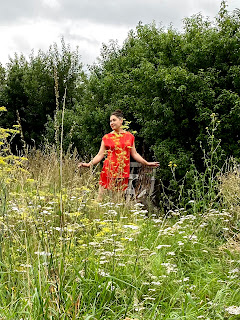Scrubby open spaces near the Wandle are full of Goldfinches this year, balancing on seed-heads with the acrobatic prowess and grace of Cirque du Soleil performers. They are handsome-looking birds - crimson faces, a flash of gold on their wings. So delightful, in fact, that the collective noun for goldfinches is a “charm”. But behind the goldfinch’s smart exterior lies a dirty secret - their nests. Most small birds carefully dispose of their chicks’ fecal sacs to avoid alerting predators to the location of the nest, but goldfinches take a more laissez-faire approach, giving their nests a ‘portaloo on the third day of a festival’ appearance.
Why am I talking about bird poo on a sustainable fashion/art project blog? During the last eighteen months, we’ve probably all had times where we’ve needed to resemble a goldfinch, while various aspects of our lives might have more closely resembled a goldfinch nest. Online, surrounded by retouched, carefully selected images of perfection, it’s easy to forget that everyone else’s fecal sacs are just out of shot*, or are being dealt with by other people.
*not literally, I hope. That would be gross.
Even though I’m not social media’s target market for apps where you can edit your own face, I’ve still felt the pressure of perfectionism, even creeping into things like hobbies. Should my walks be achieving a more impressive step count? Should I be attempting a Serious Walking Challenge? Should I share photos of that embroidery/knitting project that isn’t quite up to my exacting professional standards? When I was furloughed in March 2020, a couple of hobbies became my coping mechanisms, and they helped enormously with my sometimes overwhelming emotions, mostly because I was doing them in small, imperfect ways.
Walking couldn’t be about covering great distances, or visiting magnificent landscapes, so it became about which nearby trees were unfurling their new leaves, which wildflowers were growing by the path, whether I would see mallard ducklings or moorhen chicks.
Sewing while I was furloughed from my job as a costume maker helped to remind me just what a brilliant and varied skill it is, and how effective it can be when you use the simplest techniques. I was able to reupholster furniture, make PPE for NHS workers, upcycle clothes and protest, all from my living room or garden. My embroidery practice helped me process my emotions about the pandemic in contrasting ways; although I spent time gently embroidering birds or flowers to calm my roiling thoughts, I also angrily embroidered sarcastic things about Dominic Cummings, the government’s lack of support for the theatre industry, and the relaxation of covid restrictions solely for people who wanted to go hunting. And it felt very satisfying, although these pieces won’t be winning any Royal College of Needlework awards.
After a year back at work, with pandemic exhaustion making my pre-pandemic busyness impossible, I’m embracing the quick, scrappy project again.
The Goldfinch two-piece playsuit was made from one and a half metres of crinkle viscose, from my Wandle Wardrobe fabric haul. I made the whole outfit in two hours, using a pre-existing pattern for the shorts and a simple rectangle shape for the top. It’s far from perfect; the hems on both garments are just overlocked, the gathering on the waistband isn’t very even, the topstitching isn’t very precise. But I’ll just be wearing it to chill out on a nice day, no famous fashion designers are going to leap out from behind a tree and give it a mark out of ten.
So while I don’t think we should adopt the Goldfinch’s bathroom etiquette, I think we can admit that a picture-perfect life during a pandemic is a bit unrealistic. I’m going to embrace imperfection, put my feet up and watch the birds for a bit. I bet I’ll feel better for it.
















